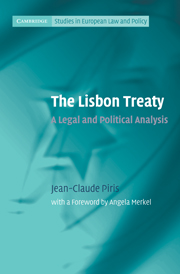Book contents
- Frontmatter
- Contents
- List of boxes
- Foreword by Angela Merkel, Chancellor of the Federal Republic of Germany
- Acknowledgements
- Table of cases
- List of abbreviations
- Introduction
- I The origins and birth of the Lisbon Treaty
- II General provisions
- III Democracy
- IV Fundamental Rights
- V Freedom, Security and Justice
- VI Institutions
- VII External affairs
- VIII Financial, economic, social and other internal affairs
- Conclusion: the Lisbon Treaty and beyond
- Appendixes
- References
- Index
- References
VI - Institutions
Published online by Cambridge University Press: 05 June 2012
- Frontmatter
- Contents
- List of boxes
- Foreword by Angela Merkel, Chancellor of the Federal Republic of Germany
- Acknowledgements
- Table of cases
- List of abbreviations
- Introduction
- I The origins and birth of the Lisbon Treaty
- II General provisions
- III Democracy
- IV Fundamental Rights
- V Freedom, Security and Justice
- VI Institutions
- VII External affairs
- VIII Financial, economic, social and other internal affairs
- Conclusion: the Lisbon Treaty and beyond
- Appendixes
- References
- Index
- References
Summary
Adapting the institutions to an enlarged EU
Among the most visible changes brought about by the Lisbon Treaty are the reforms of the institutions: these reforms concern the number of the institutions and their respective powers, composition and internal functioning. The institutions will now have to cope with the increased rights given to other political actors, such as the national parliaments, the Committee of the Regions and the citizens themselves.
The Lisbon Treaty increases the number of the EU institutions from five to seven, by giving the European Council and the European Central Bank the status of institution. The respective powers of the institutions are somewhat reshuffled, most notably through a widening of the scope of the codecision procedure, an increase in the number of cases where a (redefined) QMV in the Council will apply, a reform of the budget decision-making procedure, the creation of the new offices of a full-time European Council President, elected for up to five years, and of a Union High Representative for Foreign Affairs and Security Policy, appointed for five years, who is the president of the Foreign Affairs Council as well as one of the vice-presidents of the Commission, a reference to the Eurogroup which is chaired by a president elected by his/her peers and an extension of the jurisdiction of the Court of Justice.
- Type
- Chapter
- Information
- The Lisbon TreatyA Legal and Political Analysis, pp. 204 - 237Publisher: Cambridge University PressPrint publication year: 2010
References
- 1
- Cited by



